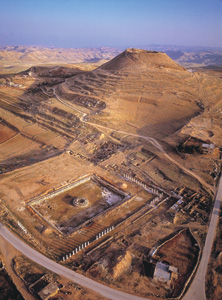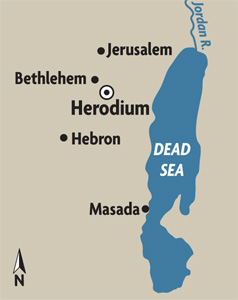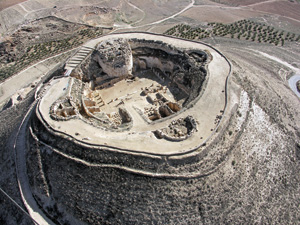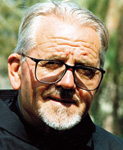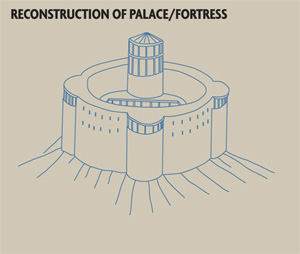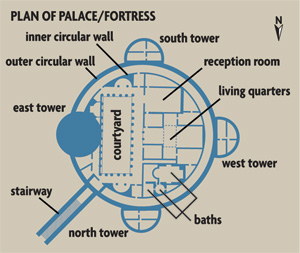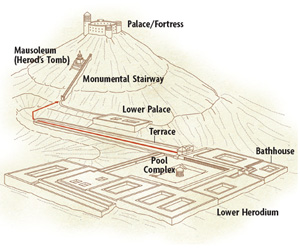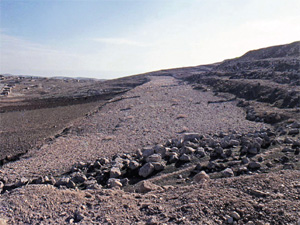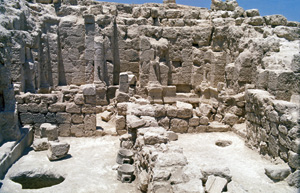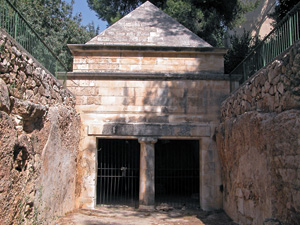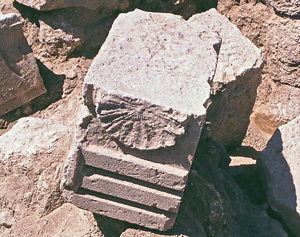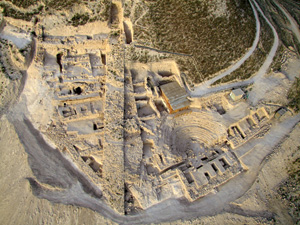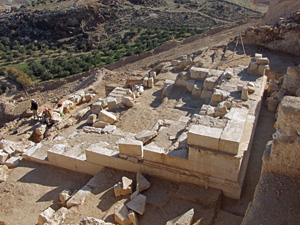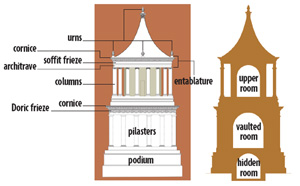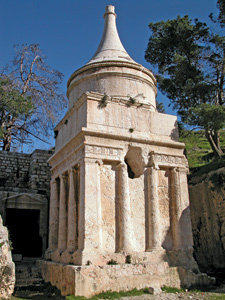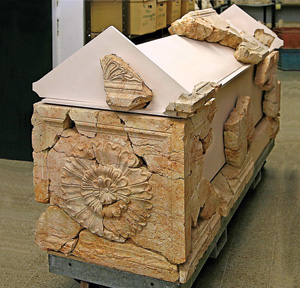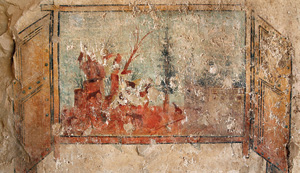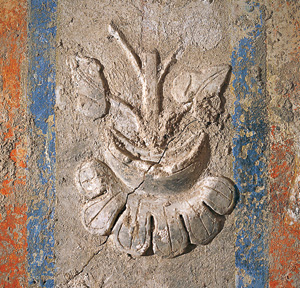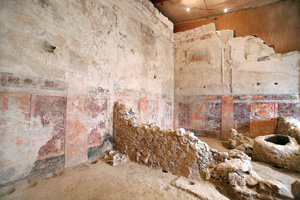In Search of Herod’s Tomb
10 views
Skip to first unread message
Pastor Dale Morgan
Jan 23, 2011, 12:39:46 AM1/23/11
to Bible-Pro...@googlegroups.com
BAR 37:01, Jan/Feb 2011
In Search of Herod�s Tomb
By Ehud Netzer
On October 25, 2010, archaeologist and friend Ehud
Netzer fell while working at Herodium, injuring his neck and
back. He died from his injuries two days later. Obituary.�Ed.
During the 38 years since I began working at Herodium, Herod�s
luxurious desert retreat, this architectural masterpiece has
yielded many treasures, but none more exciting than the 2007
discovery of Herod�s elusive tomb. Some still question this
identification, but more recent discoveries confirm my initial
conclusion. Today, I have no doubt of it.
That Herod was buried at Herodium is unquestioned. The
first-century Jewish historian Flavius Josephus tells us so in
considerable detail (see sidebar).
Herod�s earliest recorded connection to the site occurred about
three years before he became ruler of Judea. It was a traumatic
experience for the future king. By 40 B.C.E. the Parthians from
the east had conquered Jerusalem and offered their authority and
protection to Herod�s rival, the new Hasmonean king Mattathias
Antigonus. Herod fled Jerusalem secretly at night, with his family
and bodyguards, in order to find immediate asylum at Masada by the
Dead Sea. During that long journey his mother was injured when her
carriage overturned. Josephus tells us Herod was so distraught
that he nearly killed himself before learning that his mother
would recover. In the meantime the incident meant he had to stop
and fight his pursuer, Mattathias Antigonus (who was aided by
units of the Parthian army), at the desert site where Herodium
would later be built.1 Herod won
this crucial battle, allowing him to proceed to Masada, where he
left his family. He himself repaired to Rome to seek support. But
before he left, he apparently made a commitment or a vow that
here, at the site of his military triumph, he would be buried. In
Rome he was nominated by Marc Antony and confirmed by the Roman
senate as king of Judea, a position he was able to assume in 37
B.C.E.
In 28�27 B.C.E., about 12 years after his crucial survival,
Herod returned to the site and started building the grand estate
that would ultimately house his mortal remains. He initiated the
project with the construction of a magnificent palace/fortress,
later surrounded by an artificially heightened mountain that could
be seen as far away as the outskirts of Jerusalem.
He called the site Herodium. This is the only site among his
numerous architectural achievements that he named after himself. I
believe that if not for Herod�s earlier commitment/vow, this
unique site would never have been built�why else build such a
monument in the desert when he already had other desert redoubts?
His palaces at Jerusalem and Jericho would have been more than
enough to fulfill his year-round needs.
In 4 B.C.E., at the age of 70, Herod fell ill and moved to his
winter palace at Jericho. There, Josephus tells us, he was
consumed with �uncontrolled anger.� His condition soon
deteriorated further. He developed ulcers and swollen feet. His
breathing became labored. (See Josephus�s graphic
description.) Modern physicians have suggested that Herod
suffered from age-related failure of the heart and kidneys, with
terminal edema of the lungs.a None
of the attempted treatments was effective. In great pain Herod
finally died.
Herod was hated by many of his subjects, especially by Jews,
and he knew it. Shortly before his death, Josephus tells us, he
ordered a group of prominent Jewish leaders imprisoned in
Jericho�s hippodrome and gave instructions to have them killed
upon his death to ensure that the mourning at his funeral would be
genuine. Fortunately, this order was disobeyed, and the men were
released.2
Nonetheless, Herod�s son Archelaus organized an elaborate
funeral for his father, who no doubt even designed the program,
including a royal procession (see sidebar)
conveying the body to Herodium, where it was interred as Herod had
wished.
For all his detailed description of the funeral, however,
Josephus failed to mention one crucial matter: Exactly where at
Herodium was Herod buried?
Herodium lies in the barren Judean hills, 8 miles south of
Jerusalem and 3.5 miles east of Bethlehem. The French explorer
Richard Pococke drew the first modern plan of the conical mountain
with a flat top in 1738, but only in the 19th century was it
identified as Herodium, by American explorer Edward Robinson and
later confirmed by German architect-archaeologist Conrad Schick.
The Arabic name, Jebel (�Mountain�) Fureidis, is probably a
corruption of the ancient Greek name, Herodis.
The first archaeological excavation at the site�focusing on the
palatial hilltop fortress�was carried out in 1963�1967 by Father
Virgilio Corbo of the Studium Biblicum Franciscanum. Located in
the West Bank, Herodium was then part of Jordan, so, as an
Israeli, I could not visit his excavation. But on one of his
visits to Masada (where I was working with Yigael Yadin), Father
Corbo gave me a full description of his excavations at Herodium.
Since I had a particular interest in Herodian architecture (my
training had been as an architect), I was fascinated by the site:
The architectural remains on such a grand scale would fit very
well Josephus�s designation of Herodium as Herod�s burial place.
When I began digging here in 1972, I focused not on the
structures within the palace/fortress of Upper Herodium that Corbo
had already exposed (I later added an architectural study to it),
but rather on the vast complex in the valley below, which I have
named Lower Herodium.
The palatial fortress atop the mountain is an imposing circular
building 200 feet in diameter. Two concentric walls, separated by
12 feet, encircle the building, rising to a height of 100 feet,
enough for seven stories within the perimeter wall. The upper five
stories of the circular wall were used not only as corridors that
led to various parts of the massive round structure, but also for
storage. The bottom two stories, essentially cellars below the
building�s ground floor, were probably used for additional
storage. Once the artificial cone-shaped hill was built around it,
only one-third of this tall palace structure stood above the
surrounding fill.
Four towers rise from the northern, southern, eastern and
western compass points of the palace�s outer wall. Three of them
are semi-circular in plan, measuring 45 feet in diameter; they
probably contained guest rooms and dormitories. The east tower,
however, is larger�a full circle 55 feet wide. The upper part has
not survived. The part that remains, unlike the other three
towers, is solid. The highest part of the tower probably housed a
secondary dwelling unit, where Herod and his guests could enjoy
the extraordinary view and the breeze on hot days.
The luxurious palace within the circular walls was divided into
two symmetrical halves. The eastern half featured a large
courtyard with an enclosing peristyle. The western half consisted
of living quarters, including rooms for sleeping, entertaining and
dining, as well as a complete Roman bathhouse.
Some scholars speculated that Herod had been buried in this
palatial fortress, perhaps within the solid base of the circular
east tower. Some even noted the similarity of the round
palace/fortress to the contemporaneous mausoleum of Augustus,
Herod�s patron, in Rome. I had been digging in Lower Herodium for
nearly a decade when in 1983 geophysicist Lambert Dolphin studied
the supposedly solid east tower. Using rock-penetrating radar, he
claimed that his team had detected a hollow chamber at the base of
the tower. However, Daniel Vaks of the Geological Survey of
Israel, who personally followed Dolphin�s tests on my behalf,
contested this observation. Vaks said he did not see any definite
evidence of a cavity. Moreover, our research into the bedrock on
the slope of the hill to locate a possible burial cave under the
tower came up with nothing.
There is another reason why I discount the theory that the
palace was meant to serve as Herod�s tomb: As a Jew, Herod would
not have been buried inside a residence because it would render
the entire building ritually impure.
Although Herod�s tomb was always in the back of my mind when I
worked in Lower Herodium, my objective during those early years
was to understand this huge architectural complex. When I began I
was 38 years old, half my age today!
The site was fascinating, despite the fact that Herod�s tomb
eluded us year after year. Our excavations continued through 1987,
resumed in 1997�2000, and again in 2005. We exposed several areas
of the nearly 40-acre complex.
Early on it became clear that Lower Herodium had been carefully
planned in conjunction with the mountaintop palace/fortress; it is
laid out on precisely the same architectural axes.
Lower Herodium, too, was built as a palatial resort, a sort of
country club in modern terms. Here Herod could receive and
entertain an abundance of guests. One of the central features of
Lower Herodium is a large plastered pool, for both swimming and
small-boat sailing. The pool measures 210 feet by 135 feet and is
9 feet deep. It is surrounded on three sides by a portico, with
halls on the east and west that may have contained Herod�s throne
room. In the center of the pool stood an island with a
40-foot-wide round building with a roof and columns. The leveled
area around the pool was covered with thick, brown-black soil
suggesting that a lush garden was planted here, a real contrast to
the surrounding desert.
A bathhouse was located southwest of the pool. The walls were
painted in decorative patterns and imitation marble. Mosaic floors
featured geometric, floral and fruit designs (but no humans or
animals).
One of the most striking features of Lower Herodium is a large,
leveled man-made course (1200 x 100 ft), much like a racecourse,
that is easily distinguishable from the adjacent natural terraces.
At first I thought this might be a racetrack of sorts, perhaps
part of an ancient hippodrome. But I soon abandoned this idea; the
course was much too narrow for this purpose. But it would have
been just right for the parade ground of a funeral procession.
This became more likely when, not far from the pool at the
western edge of the course, we discovered a structure that we call
the Monumental Building. At first, we thought this might be
Herod�s mausoleum. It might well have had a pyramidal roof, as did
Jason�s Tomb in the Rechavia section of Jerusalem and the Tomb of
Zechariah in the Kidron Valley. In the end, however, there was no
evidence that the Monumental Building was a mausoleum.
Although we had not found the tomb, we had its context: The
course was for the funeral procession. The Monumental Building
turned out to be a triclinium, or dining room with couches
on three sides, for mourning meals or other gatherings.
As our excavations progressed adjacent to the course, another
tantalizing hint suggested Herod�s tomb might be nearby: a mikveh
(ritual purification bath). This could have been for use during or
after the funeral proceedings.
A group of fallen, elegantly carved monumental stones gave us
the feeling that the burial monument must be nearby.b We of course searched for their
source. A short distance from the Monumental Building, in a
much-later Byzantine church, we found many of these elegant ashlar
blocks, obviously not original to the church, but in secondary
use. Then we noticed among them the remains of a Doric frieze,
also in secondary use. Were these stones part of Herod�s burial
monument? Were these the remains of a second monumental building,
the mausoleum? It took us ten years of excavation (spread over 25
years, as a result of the intifadas) to locate the
foundations of the building that had provided the Byzantine church
with such elegant stones. The stones in the church were in fact
from the building that, we believe, Herod erected to house the
entrance into his elaborate burial place.
When we came back to work in 2005 (after the second intifada),
we made one further effort to find the royal burial cave in Lower
Herodium, but we were unsuccessful.
In the summer of 2006, we turned our attention to the slope of
the hill, in the vicinity of the monumental stairway that ran up
the hill from Lower Herodium to the palace/fortress of Upper
Herodium. We first followed an ancient wall along the northeastern
slope, hoping that it would lead us to the burial place (a cave?)
at the bottom of the round eastern tower. When no clue was found
here, in the spring of 2007 we returned to the vicinity of the
monumental stairway and slowly we began to reveal some fragments
of reddish stone along the northeastern slope that appeared to be
from an elegant sarcophagus. Following these stones, we were
finally led to the discovery of Herod�s mausoleum.
It is constructed of a hard, white limestone known as meleke
(which means �regal� in Arabic). The source of this special,
high-quality stone is only a mile south of Herodium, but the
mausoleum is the only building at the site to use this particular
kind of limestone. The quality of the architectural decorations is
superb. The lack of patina, however, hints at the relatively short
time the mausoleum existed before it was destroyed.
The mausoleum measured 30 by 30 feet at its base and (putting
all the pieces together) reached a height of more than 70 feet. It
contained three rooms, one on top of the other. The lowest was
�hidden� within the podium that sat on the natural bedrock. The
podium served as the base of a vaulted room about 20 by 20 feet.
Its outer walls probably featured pilasters (rectangular
column-like protrusions). These bore a Doric frieze with rosettes,
topped by a decorated cornice.
Above this stood a circular room (about 14 ft in diameter and
17 ft high) surrounded by a portico of 18 monolithic columns. The
columns supported a round entablature composed of an architrave, a
soffit frieze and a highly decorated cornice (all marked on the
reconstruction). This room was probably covered by a dome, in
contrast to the barrel-vaulted ceilings of the two rooms below. We
assume that this uppermost room contained Herod�s sarcophagus and
probably others as well.
The curved conical roof of this room was adorned on the outside
with five urns, four of which apparently stood at its base while
the fifth, set upon a large Corinthian capital, crowned its top
(see reconstruction), similar to the top of the famous Khazneh and
Deir monuments in Nabatean Petra.
Oddly enough, we found no evidence of a stairway leading
directly to the mausoleum. Apparently a temporary wooden bridge or
stairway was erected prior to each burial (assuming there was more
than one).
The area around the mausoleum was reshaped into a terraced
formal garden, as we know from some layers of dark brown soil
especially brought here for this garden. The garden was irrigated
by a pool on one side.
The reason we believe that there was more than one burial in
the mausoleum is that, in addition to the reddish stone
sarcophagus fragments, we found evidence of at least two more
sarcophagi made of white limestone. Herod was not the only one
buried in the mausoleum.
Since no inscription has been found, it was unclear at first
which of the three sarcophagi was intended for Herod. The reddish
sarcophagus was adorned with rosettes that were carved and
polished meticulously. The larger of the two white sarcophagi was
decorated with elegant floral patterns. The other one was
undecorated. My supposition is that Herod was buried in the red
sarcophagus and the other sarcophagi were for family members,
perhaps Herod�s fourth wife, Malthace (the mother of Archelaus,
who ruled for a decade after his father�s death), and Archelaus�s
second wife, Glaphyra.
The fragments of the reddish sarcophagus were scattered all
around the destroyed mausoleum, in contrast to the fragments of
the white sarcophagi, which were found in a group at the base of
the mausoleum. That the fragments of the reddish sarcophagus were
scattered suggests that it had been purposefully destroyed,
intentionally smashed. This conclusion is reinforced by what
appear to be hammer marks on some of the sarcophagus fragments.
Who destroyed the monumental mausoleum and this sarcophagus? My
guess is that they were Jewish rebels who occupied the site during
the Great Jewish Revolt (66�70 C.E.). (Rebels also occupied the
site during the Second Jewish Revolt, the so-called Bar-Kokhba
Revolt [132�135 C.E.].) The evidence of their presence is
pervasive at the site (we even have their garbage heaps containing
dated coins). Hatred of the king is amply supported by Josephus
and apparently persisted at least 70 years after Herod�s death.
One thing we did not find, however, is a plaque saying, �Here
lies buried Herod the Great.�
Not long after we announced the discovery of Herod�s tomb in
2007, my good friend British architectural historian David
Jacobson expressed his doubts, noting the lack of any
inscriptional identification of the remains.3
Since then, we have finished digging the whole area around the
monument, exposing more of its architectural elements. This has
enabled our capable architect-archaeologist Rachel Chachy to draw
a detailed reconstruction of the mausoleum. If the same remains
had been found near Jerusalem, it might have been risky to
identify the monument as belonging to Herod. But this is Herodium,
Herod�s personal monument, named for himself�indeed, the only one.
And Josephus has told us Herod was buried here. There can be
little question who was buried here. The absence of any
inscription should not detract from this conclusion. Many large
ancient tombs in Israel have no inscriptions identifying the
deceased, including the well-known Cluster 14 tombs in Beit
Shearim, one of which has been attributed to the great rabbi Judah
ha-Nasi, compiler of the earliest rabbinic code, the Mishnah.
Duane Roller, professor emeritus at the Ohio State University,
is another doubter. A distinguished Roman historian, Roller
concedes that the tomb we have found belonged to someone of noble
lineage, but he remains convinced that Herod lies at the solid
base of the east tower on the summit. Having spent much of my life
studying Herodium against the backdrop of Herodian architecture
and the historical sources (Josephus in particular), it became
clear to me that one cannot separate the monumental remains at the
site, the life story of Herod and his architectural abilities.
The newly found mausoleum at Herodium was the right monument in the right place. I have practically no doubt that we have correctly identified Herod�s burial site.
The newly found mausoleum at Herodium was the right monument in the right place. I have practically no doubt that we have correctly identified Herod�s burial site.
The precise spot where we ultimately found the mausoleum eluded
us for decades. We excavated almost all of Lower Herodium without
finding it. Time and time again over the years, our hopes were
dashed. Once we located the funeral course, the mikveh and
the triclinium, however, I thought surely we must be
close. But again we failed. Excavating on the northeastern slope
of the hill was a last desperate effort after years of
disappointment. But here it was!
I do believe that Herod originally intended to be buried closer
to the end of the funeral course and the mikveh and triclinium
of Lower Herodium. What made him change his mind?
I believe it was a decision he made late in his life. Herodium
was an early accomplishment, along with his major palaces in
Jerusalem and at Jericho and Masada. He then spent 10 or 12 years
(c. 22�10 B.C.E.) on the construction of his most enormous and
prestigious enterprises: the Temple Mount in Jerusalem and the
port of Caesarea Maritima.
During those years, he traveled abroad to Asia Minor and Rome.
I believe the idea for a Roman-style mausoleum was inspired by the
burial monuments he saw during these trips.c
After the inauguration of the great port at Caesarea in 10
B.C.E., most of his best builders were now free to work on other
projects. The mausoleum then became a priority.
Herod no doubt took a personal role in choosing the exact
location. The spot he chose faced Jerusalem and was close to the
main stairway from Lower Herodium to Upper Herodium. That it lay
outside of the protective wall that surrounded the upper part of
the hill meant no one could claim that the palace/fortress on top
would be religiously contaminated by a tomb.
The original tomb site in Lower Herodium was not completely
abandoned, however. Here the burial ceremony, attended by the
family, guests, bodyguards and the army, still took place on the
funeral course. The other funerary facilities, the mikveh
and the triclinium, were used as well.
Our exposure on the northeast slope produced one more surprise.
While following a water channel that runs close to and below the
mausoleum, we found the remains of a small but highly decorated
theater that could hold up to 450 spectators. Its special feature
is a magnificently decorated large royal box at the top of the
auditorium (the cavea).
The northern side of the box was fully open toward the stage.
The other three sides were highly decorated in secco paintingd and stucco (plaster). This is the
first time stucco technique has been found in Israel on such a
large scale.
Each of the three walls of the royal box was divided vertically
by painted pilasters. Each panel between the pilasters was divided
horizontally into three sections. The upper section was white but
at the top was painted the highlight of the room�s decoration:
imaginative windows. The windows were painted with folded
shutters. Through the windows the visitor could see a variety of
painted landscapes�lush country, so-called Nilotic scenes and the
sea featuring a large ship with sails. It is even possible in
these windows to make out animals as well as humans. The closest
parallel to these windows is in the Villa Imperiale at Pompeii.
Above the pilasters was a lavish entablature including a narrow
red painted architrave with egg-and-dart strips, a magnificent
wide white frieze decorated with scrolls, and a cornice on top.
Only a few of the nine windows have survived in situ. A
few of the others have been restored from the many fallen plaster
fragments from the fill that fell into the royal box when it was
destroyed.
Josephus tells us that Herod lavishly entertained Roman
statesmen and generals at numerous locations, including Herodium.4 I suspect that this theater was
completed for the visit of Roman statesman and general Marcus
Agrippa in 15 B.C.E. The two leaders had met a year earlier on the
island of Lesbos, where they apparently planned Agrippa�s visit to
Judea. The Italian team that must have decorated the majestic
royal box was probably sent on Agrippa�s order.
Our excavations at Herodium are continuing. What other exciting
new finds will we uncover? Only time will tell.
Acknowledgment
Most of the work at Herodium was accomplished only with the
support of donations from good friends, mainly in the United
States. My heartiest thanks to all of them.
The exposure of Herod�s mausoleum could not have been achieved
but for our capable and devoted core staff: Ya�akov Kalman (who
also excels as a farmer); Roi Porath (who has dedicated years to
exploring the Judean caves, working closely with the late Hanan
Eshel); and Rachel Chachy, an architect and archaeologist who has
been working with me for close to 15 years. Our excellent pottery
team is also critical to our work: Judith Gartner, assisted by
Rachel Bar-Nathan. I thank Marcos Edelcopp for his inspired
computerized drawings and Gabi Laron for his excellent
photographs.
This article is made possible with the generous
financial support of John P. Merrill.
Reply all
Reply to author
Forward
0 new messages

